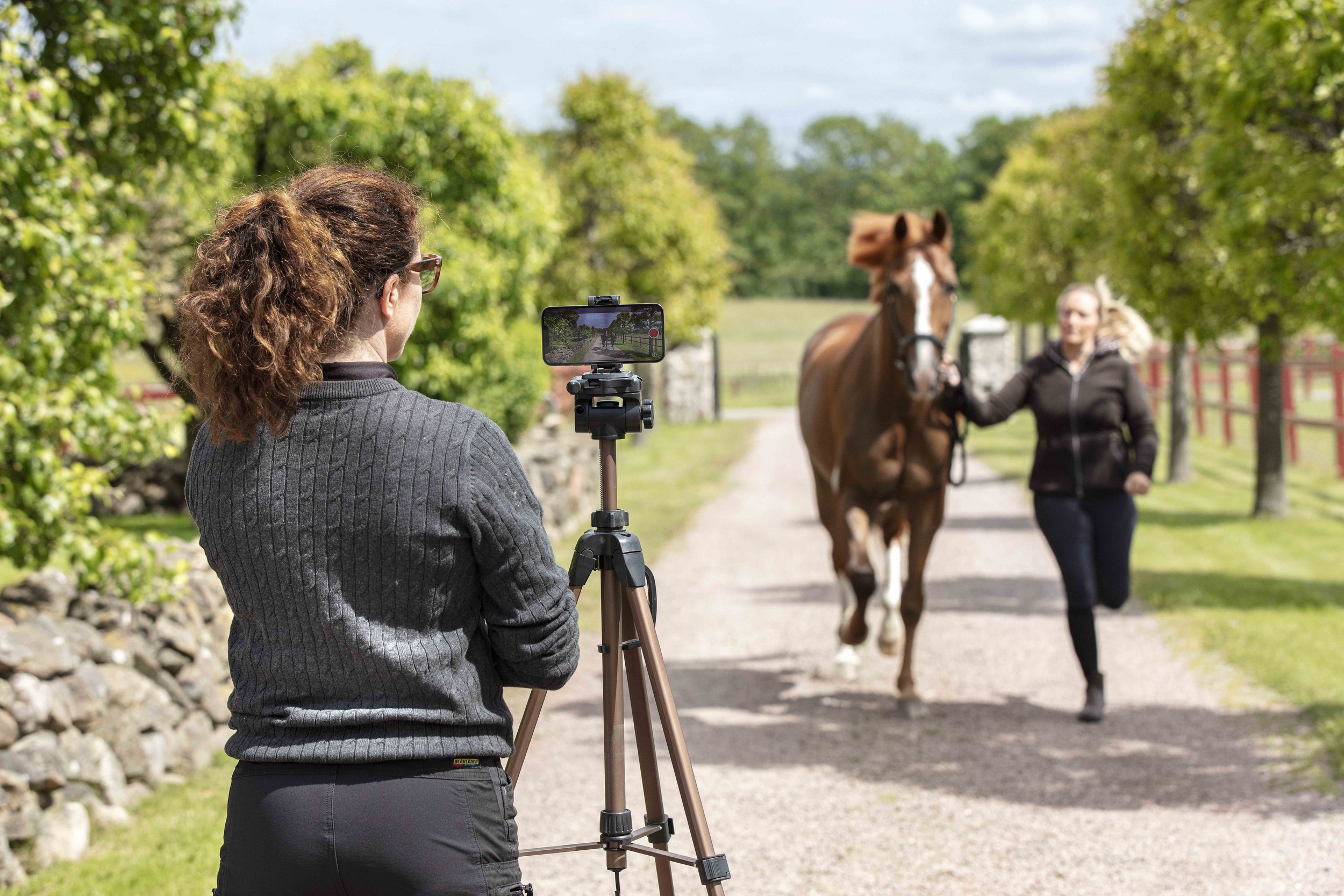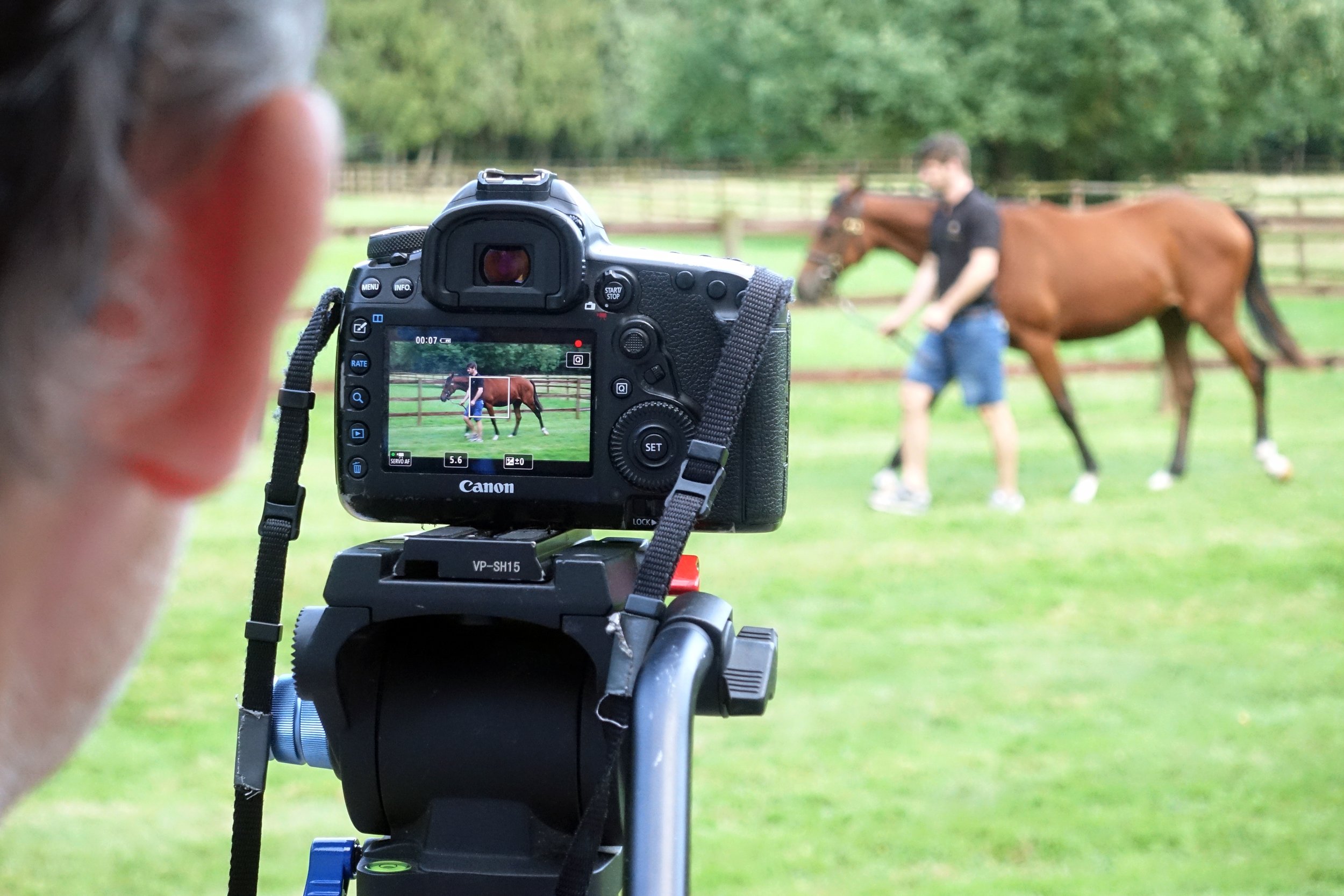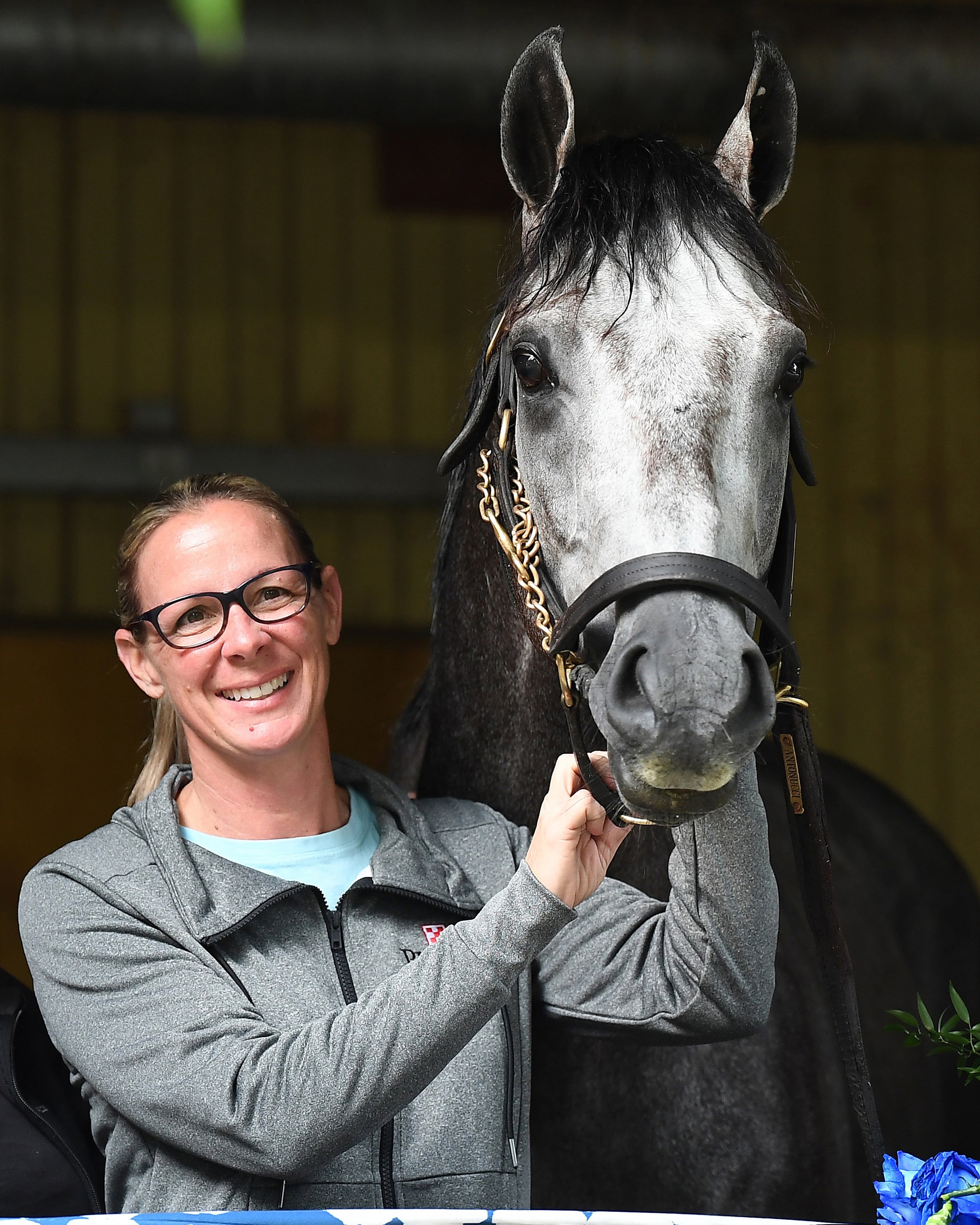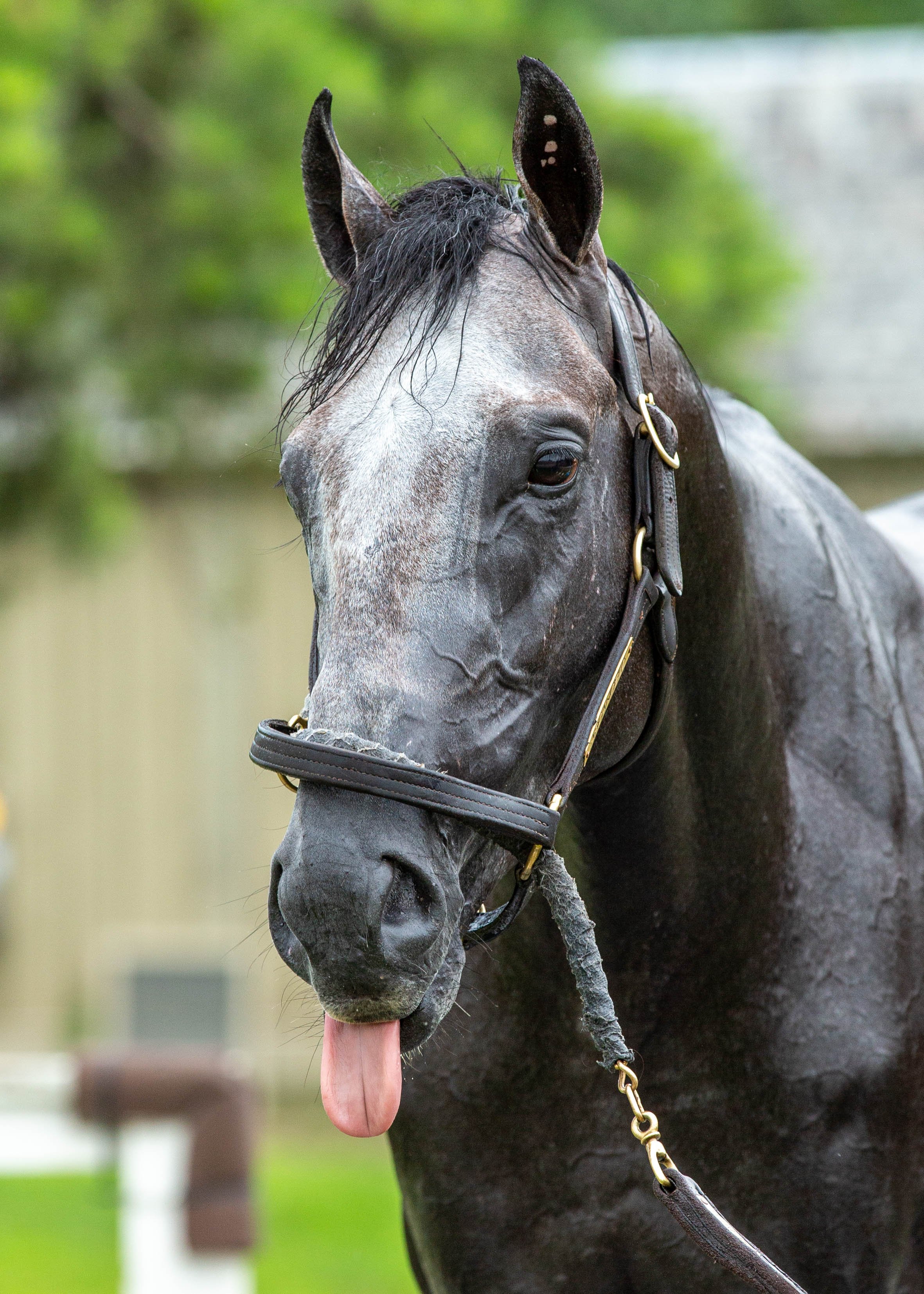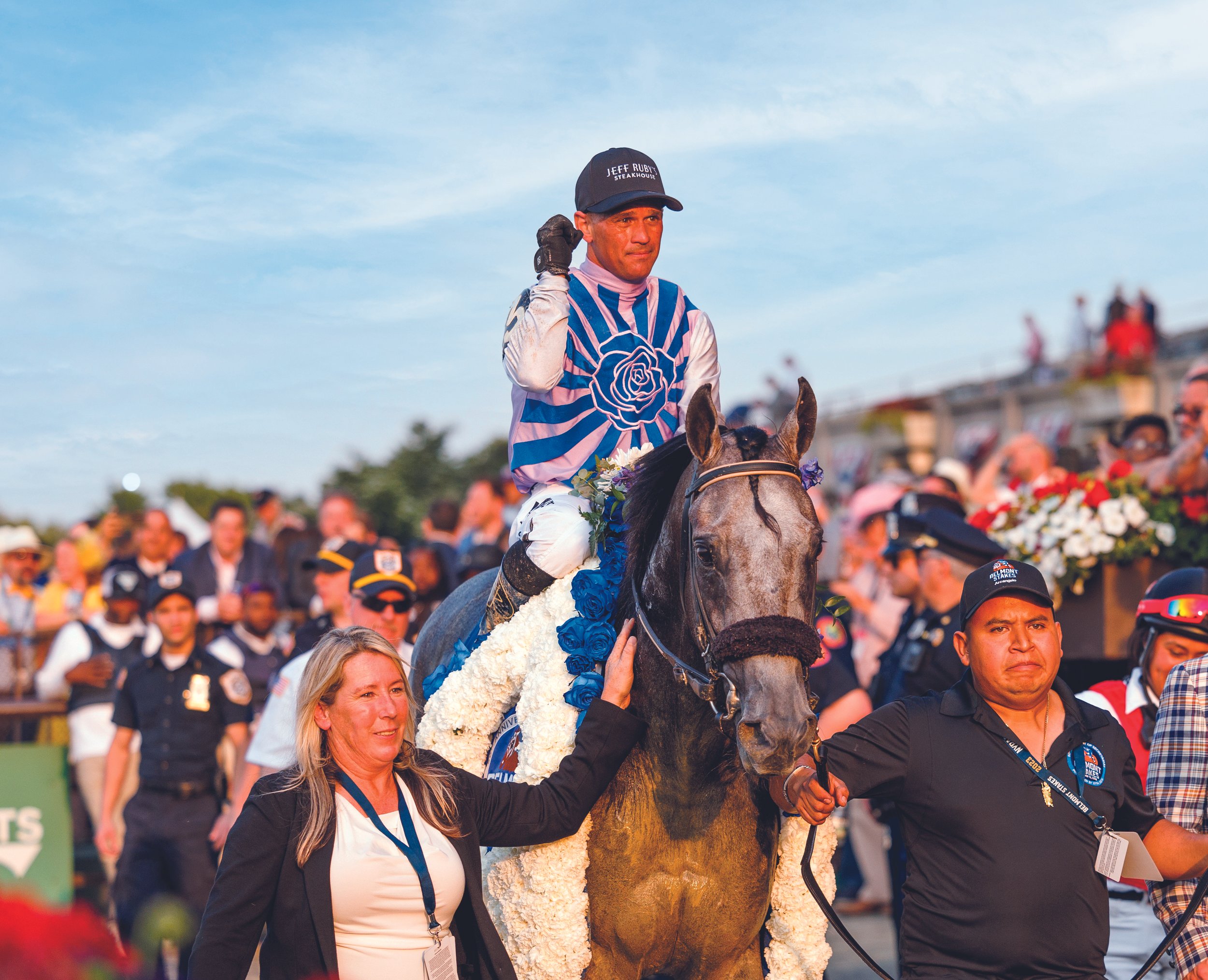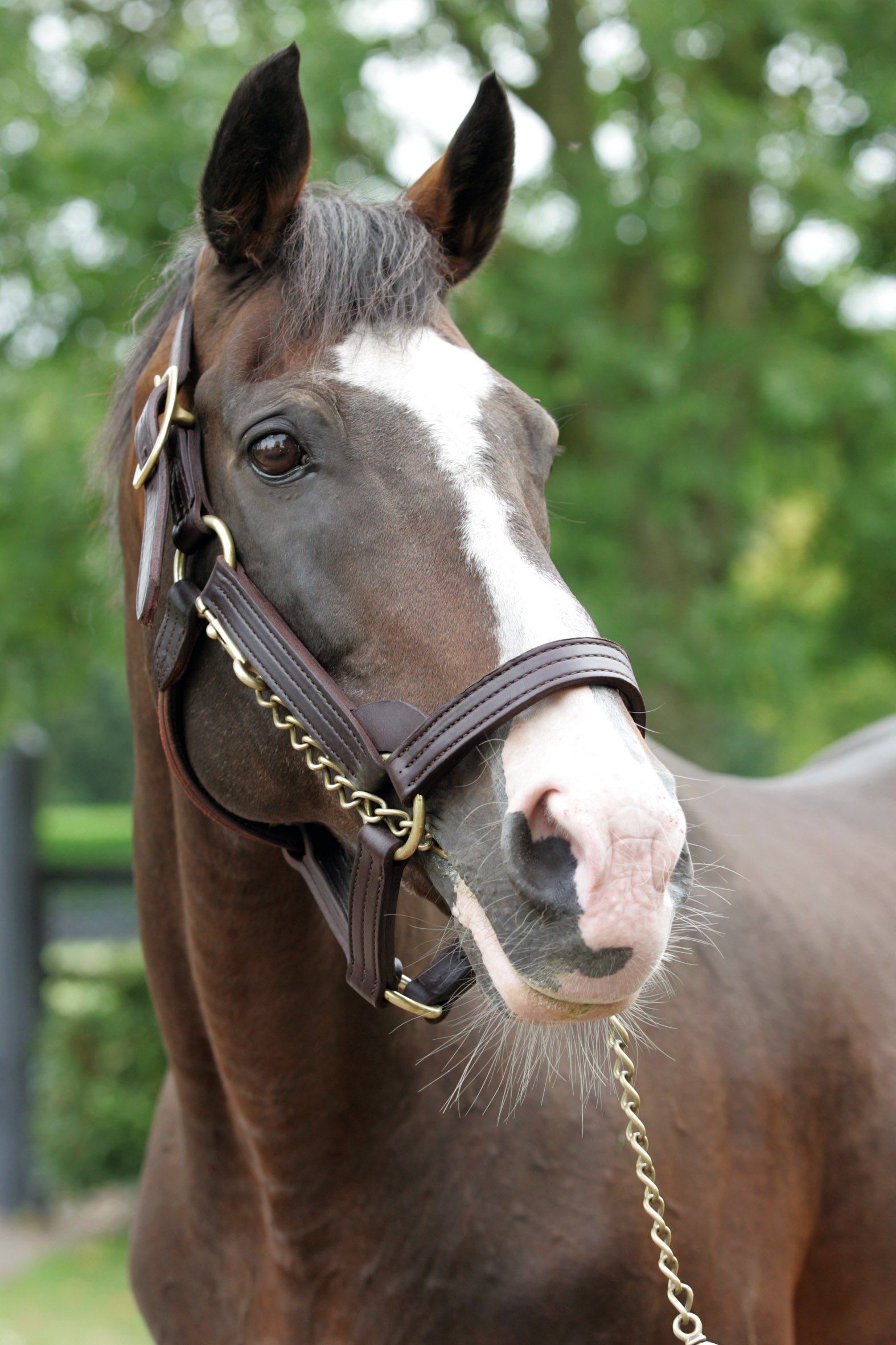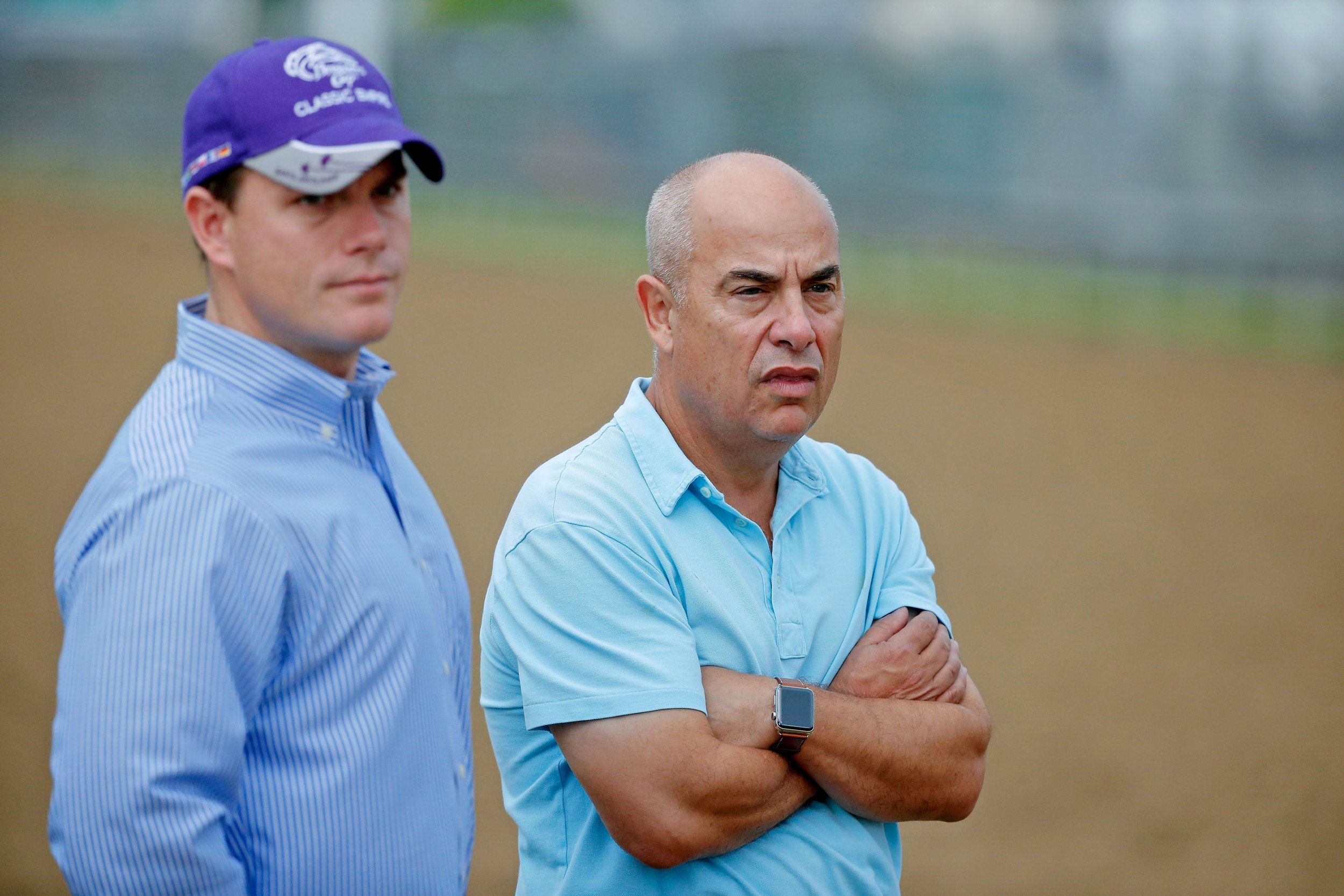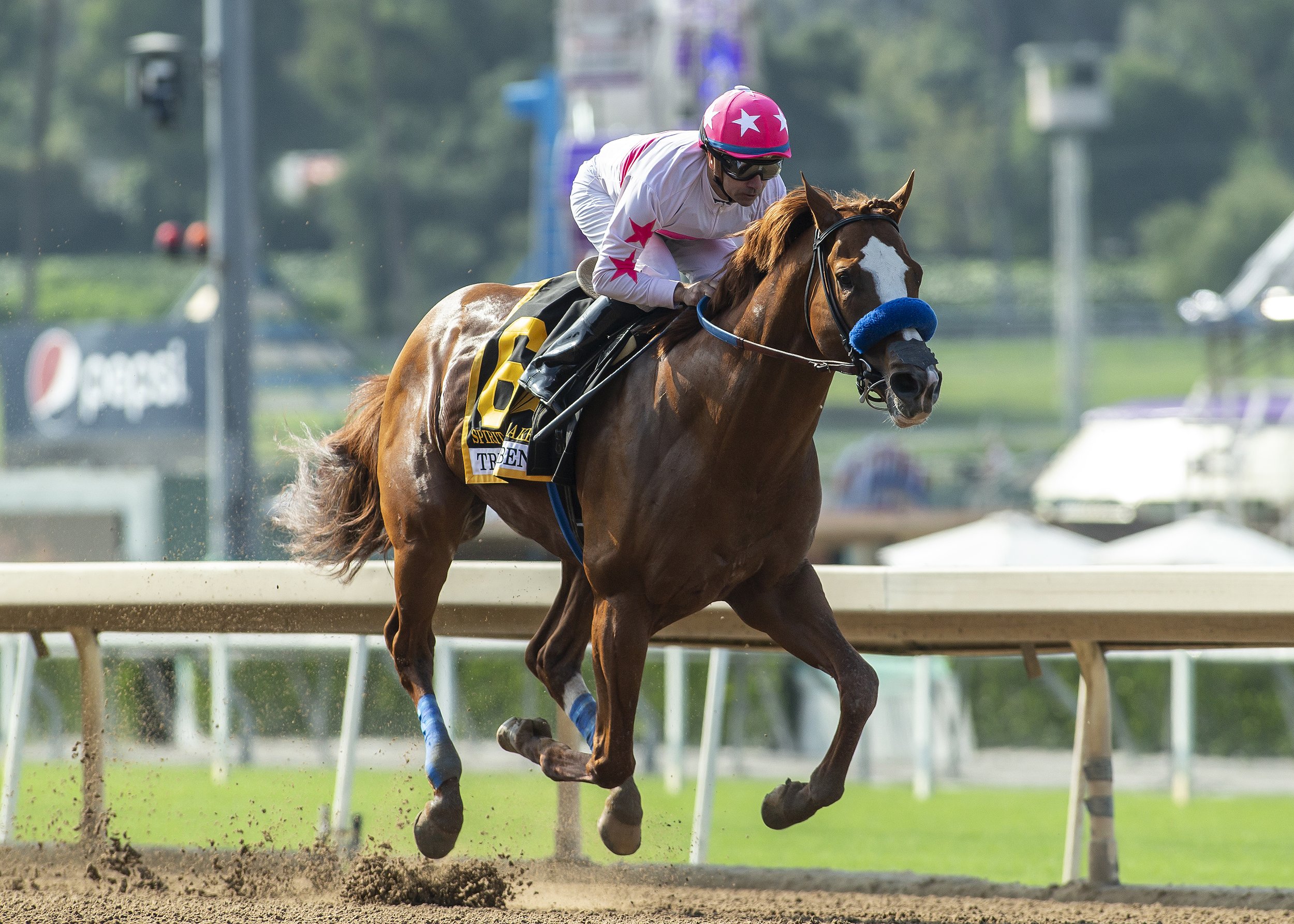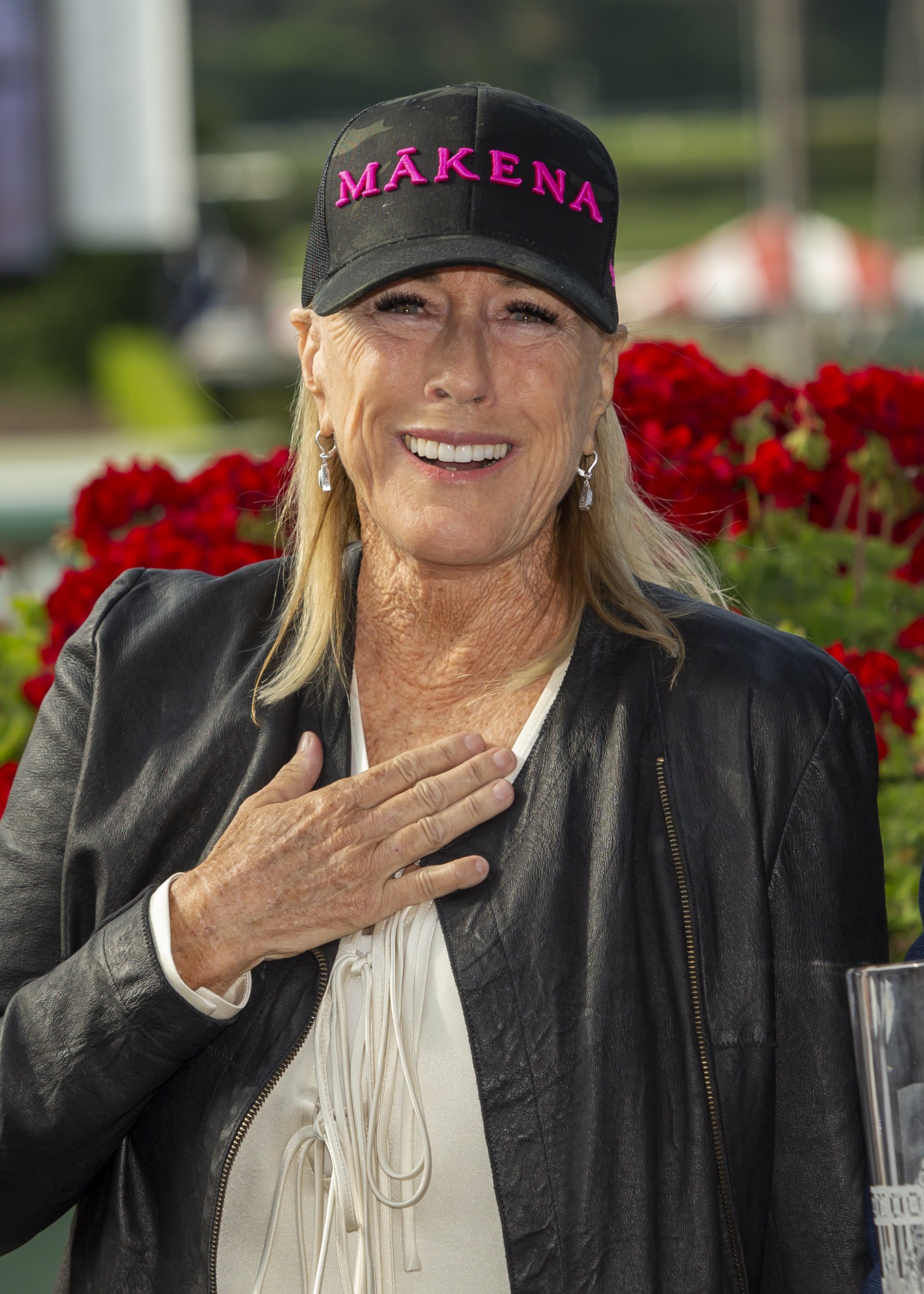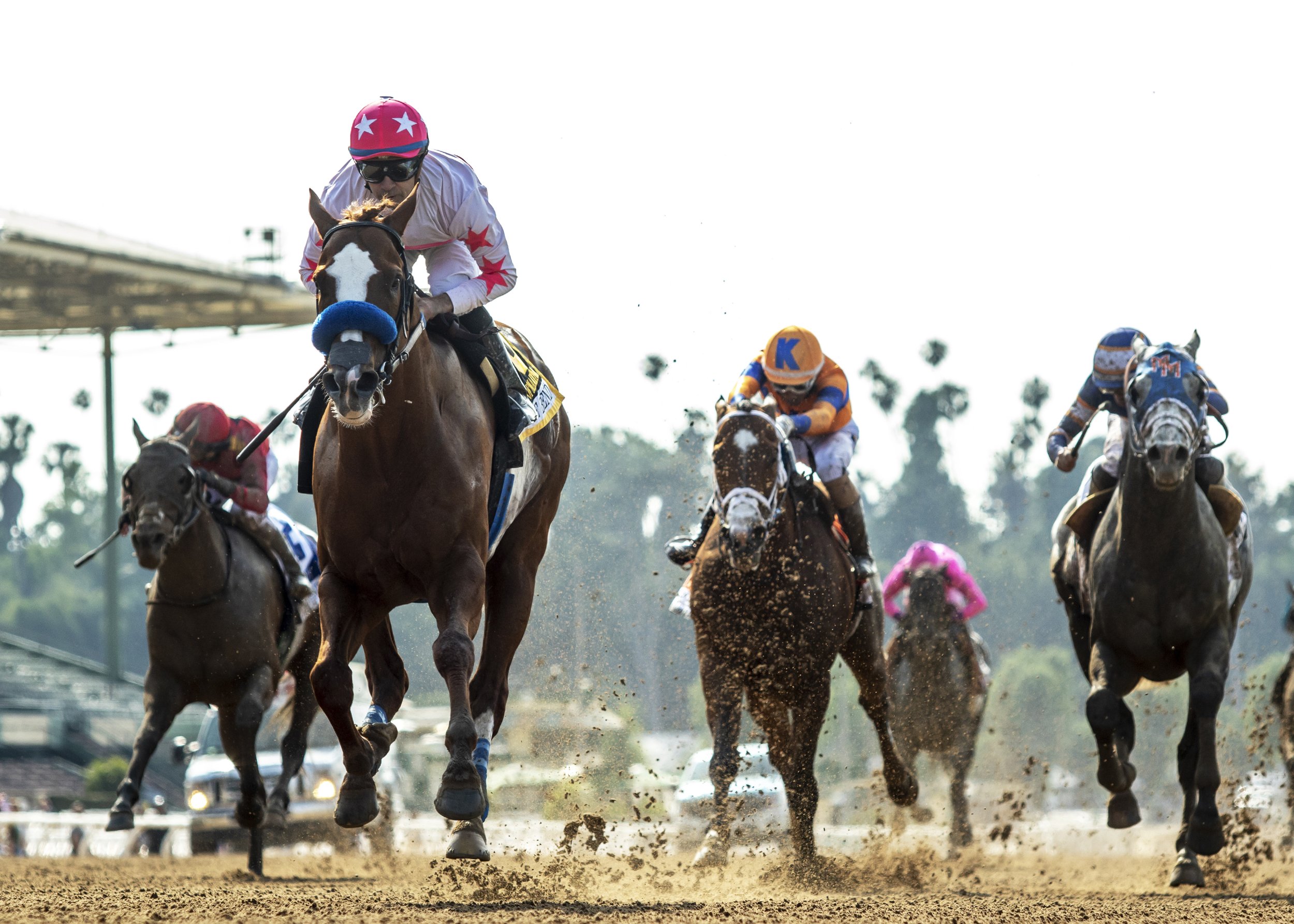It’s All About the Data: How Digital Tools Factor into a Trainer’s Work
Article by Jennifer Kelly
The tools for training horses have changed in the last two decades. This new technological era has compelled the centuries-old practices of preparing equine athletes to move with the times, especially with new regulations adding another dimension to the job. Stopwatches and notebooks now have digital counterparts in smartphones and tablets, allowing trainers with multiple barns to stay on top of their operations even if they are thousands of miles away.
With a variety of tools available now, what are trainers using as they develop their horses while also meeting the requirements of external agencies? How do they handle the influx of information and make it work for their operations? In this new age, trainers are defining their workflows with the tools that work best for them while wrestling with the added costs of the self-education necessary to incorporate these new technologies and meet the increased regulations of the Horse Racing Integrity and Safety Authority (HISA).
Options Abound
The digital age brings high-tech options like smartphones and tablets that free users from their desks. Such tools may have a learning curve but that has not stopped multiple conditioners from integrating them into their routines. “I never thought in a million years that I would see Hall of Fame trainers sitting on their horse texting or that I would see [them] recording videos of their horses working” Ron Moquett, trainer of champion sprinter Whitmore, observed.
Now, trainers have many digital options for managing their horses and their employees. A search for apps and software yields tools like Tlore, a web-based management service developed by former exercise rider and assistant trainer Tracy Attfield, and apps like Sleip and Equimetre, which collect data for assessing a horse’s performance.
Attfield’s Tlore, which is accessible on a smartphone or a desktop computer, serves as a one-stop shop for everything from accounting to tracking a horse’s workouts and daily care. “We do everything through Tlore. I've been on Tlore for a long time,” shared Jena Antonucci, trainer of 2023 Belmont Stakes winner Arcangelo. “[It] organizes everything: herd health, Coggins (an equine blood test), communication with owners, [and] can upload videos, pictures, and updates that owners have access to. So centralizing data, if you wanted to take a picture of a horse when it comes in, see how it's doing, take a 30-day follow-up or whatever, and be able to assess how they are and whatnot. It's all in one spot, easily accessible by smartphone or desktop.”
Tools like the Equimetre, developed by the French company Arioneo, collect physical performance measurements, and improve on earlier iterations of the technology, allowing users to select what data they want rather than offering multiple readings that trainers have to sort through to find what they need. Both Tom Amoss and Tom Morley are currently testing this tool in their barns to see if the data generated is a benefit to their programs. “[We’re] trying to decide whether or not that system is going to benefit us,” Amoss shared. “The old system, compared to that, is literally using a stopwatch and observing with your eyes how the horse is going. So this gives us a little bit more accurate reading in terms of times, specifically when horses work out, which is about once a week for us.”
Alongside the Equimetre is Sleip, a Swedish app that uses artificial intelligence to analyze a horse’s gait and help trainers to pick up on even the slightest variation to get ahead of potential issues. Casse has been using the app for two years as another layer of care, videoing his horses daily as part of his care regimen. “When I was introduced to Sleip, I liked it because I felt like every assistant could have one. And it takes about a minute if you know what you're doing to video it. We get the results back in less than five minutes, and I can know it can be done in Toronto, and I can have the results in my hand in Ocala within minutes.”
In addition to Attfield’s Tlore, trainers like Moquett, Casse, Morley, and John Shirreffs are using readily available services and apps to maintain the data generated by their horses. Moquett and Casse both report using spreadsheets created on either Numbers, an iPhone app, or Microsoft Excel, the nearly forty-year-old software available for use on everything from a smartphone to a desktop.
“Feed charts, the shoeing charts, the day-to-day set lists are all done on an Excel program. It means that I can be sat in Ocala, and I can put a set list together and just email it off to each division, and then they know what they're doing.” Morley reported, emphasizing the flexibility and simplicity of that software, something that Casse echoed in talking about his process.
“I did use Tlore for a while, but now we have our own deal. It's an Excel sheet that I developed over 25 years ago. I can go back and tell you, since a horse arrived, whether it was five years ago or four years ago, what the horse has done every day for those four years,” Casse shared. “We keep track of entries there, who we are going to enter, where we're going to run, where they're located through the morning. As every track is done, our assistants then send us [their information]. It tells how every horse trained that day. If it worked, there'll be the workout time, and then they put what they would like to do tomorrow, and I will then review them all. I review it every day.”
Moquett uses a custom chart that he maintains in the Numbers app for keeping up with his horses’ preparations and care and then Tlore for the financial side of his business. The iPhone app serves as the ideal tool for his barn because “you go in there and you make your own log sheets and then it saves it and shares it with whoever you want to,” he shared. “So, we use that as data keeping, [maintaining] our training charts, our workout deals, our notes. All that is there. And it's pretty cool because on that we have the people in charge of shipping, the people in charge of billing, the people in charge of payroll, and the people in charge of everything use that to get the information to feed Tlore.”
California-based Shirreffs uses several apps to cover everything from taking notes about daily training to scanning his vet book to logging his employees’ hours. The GoodNotes app, available for Apple products, serves as his training log and a repository for notes and other information. He also uses a journaling app called Day One to keep up with day-to-day conditions and Numbers for maintaining charts. All of his tools are linked and the data saved to the iCloud service. “Then if I'm somewhere, I can just look things up on my iPhone because it goes from device to device, [and then] it all goes to the cloud,” the Derby-winning trainer said.
Morley and Amoss also use handicapping tools like the Daily Racing Form’s Formulator, Ragozin sheets, and Ed Tucker’s ThoroManager to help them evaluate potential competition as well as horses that they are interested in claiming or purchasing. Such programs allow users to access detailed past performances, take notes about a potential claim’s performances and evaluate pedigree information, including how well a horse’s family ran at a particular distance or on a specific surface or racetrack.
With all of this data available to these trainers from their chosen tools, is it possible to have too much data? Each has developed systems that work for their operations, which allows them to cut out unnecessary information and focus on what is most useful. Arioneo’s Equimetre and Attfield’s Tlore are ready-made products specifically geared toward the equine industry with not only multiple options for use, but also adaptability that prevents data overload. Apps and software like Numbers, Excel, and other readily available tools allow even more flexibility, giving conditioners the ability to streamline their processes and focus on the most valuable information for their horses’ development and care.
“If you try ten new things, and only one of them is worth it, it's worth the nine failures. In the past, I have used a few different things that I thought just was too much and too time consuming,” Casse said. “We only have so much time, and you always have to decide, do the assets outweigh the liabilities? Do I get enough out of this to take my time up? And if the answer is not yes, then I move on. And I have used other things, and I've moved on.”
As digital tools evolve and their usability is more easily tailored to each trainer’s needs, they become essential parts of the daily workflow, especially now that HISA requires conditioners to register themselves, their employees, and their horses, and maintain records of treatments, medical procedures, and more.
Hello, HISA
Since July 2022, the Horse Racing Integrity and Safety Authority has required trainers to maintain records about their horses in an online portal. For some, adding the portal to their lists of tasks was another use for the data they were already collecting. “We already had it, so now we're giving it to them,” Moquett shared. “So, it was a priority for us to make sure we were staying legal, to write down what we were doing, and now it's priority to keep it, to make sure we're staying compliant with the rules that they have set.”
What digital tools like Tlore do goes beyond bookkeeping and the care and feeding of horses: they help trainers track the data HISA requires documented. “You just have to play by the rules and input what you're supposed to be inputting and keep track of your horse's medical records,” Antonucci shared. “If it gets ace (acepromazine), it goes in. Like checking joints, it gets put in. So that's just very basic. Whatever the veterinarian does, anytime they touch a horse at a racetrack gets put in.”
“Every little thing we do now, we record. Definitely, that's what HISA was there for,” Casse said. “HISA is saying, look, we need to let everybody know when a horse changes hands, what's been done previously, and that's important. It's a pain, but in the end, it's going to save horses’ lives, and that's what we're all trying to achieve.”
The portal gives claiming trainers data they did not previously have. “Now, if you claim a horse, you are privy to their medical records for the past 60 days,” Morley shared. “So, you can not only see when they were vaccinated and wormed, et cetera, et cetera, but also if they've had intra-articular injections, if they've had a period of colic or sickness, et cetera, over the last 60 days.” This enables trainers to understand what the previous barn had been doing with the horse as they integrate the new trainee into their program.
Even though the portal does add another task to trainers’ to-do lists, it does have value, as Morley pointed out: “That's actually a very good portal for keeping track of records. So rather than us having to flick back through our veterinary records as to when they were last vaccinated, et cetera, it's all logged in HISA anyway.”
Still, while this new requirement does have its upsides, the portal and the work needed to maintain the required data has become yet another task on a trainer’s long to-do list.
More Data, More Work
But this kind of digital diligence has its disadvantages. In addition to keeping up with their horses’ day-to-day management, both on the track and off, trainers must document all medical and therapeutic treatments and log that data into HISA’s portal in order to stay compliant. This is especially important for horses coming off a long layup at an off-site facility. Tools like Tlore and other digital workflows might help conditioners maintain this needed information, but those tasks also use two valuable resources: time and money.
For Amoss, the added layer of HISA meant adding another full-time employee to his operation, one in charge of keeping up with the required information to adhere to these new regulations. “The biggest thing with HISA is that the requirements that we have are not only costly to the trainer to manage it, but it's costly to the owner in terms of the things that we have to do. In a world where the day rate, which is what an owner pays a trainer every day to train their horse, the margins for almost all of us are very razor thin. And now we've got to add a new dimension to that,” Amoss observed.
John Shirreffs points out the simplicity of the training process prior to HISA and its requirements. “I think that we all feel like we're being second-guessed, though. We have to substantiate our decision. Before these new tools, I didn't have to keep up with anything. All I had to do was mark the trainer card, and that would be written in the vet book, and that was it. I didn't really need to have all this.”
“I think they all detract from the ability to train because I think it takes time. And that's taking time to enter all this stuff where I could be walking down the shed row and observing a horse or talking to a groom about a horse or something like that,” he shared. “Because I need to keep records, it takes away from the time available, because, by 11:00, you want to wrap things up, so the horses have a chance to rest. You don't want to be standing in front of the stall staring at them when they want to take a nap.”
Amoss, who worked for Jack Van Berg and Frank Brothers before going out on his own, remembered that “they did all their bookwork and all their recording by hand. There is an advantage to that, in my opinion. And the advantage is that you can, on a daily basis, open that book and review your horse.” The Kentucky Oaks-winning trainer prefers that because “it tends to refresh my thinking on those horses as opposed to turning on my iPad.”
The key for any trainer as they focus on developing their horses is to find workflows that balance the necessities of HISA with the methods that have brought each success. In this transitional moment, these digital tools afford conditioners opportunities to find what works for them as they adapt to these new requirements.
Going Forward
Tools like Equimetre and Sleip are on the cutting edge of digital tools available now, using artificial intelligence and other advances to help trainers keep an eye on their horses’ physical conditions and detect any subtle changes that might evolve into an issue. Along with HISA’s regulations, these provide another layer of preventative care for the animals at the heart of the sport. These advances push racing forward and necessitate adapting to the times, taking old-school practices into the digital age.
“Here's the thing with old school. I am old school in my mindset of horsemanship, and I'm old school as an approach to getting the horse trained,” Moquett observed. “But saying that I'm old school as an excuse not to get with the times of what's needed for this kind of stuff, it's like saying, no, we’re going to haul our horses on a train instead of flying them. We have to [adapt]. That's what's required.”
Along with these tools, Casse suggests another advancement that could help trainers: “I'm hoping that somewhere in the future that we'll have some type of report card that goes with every horse, a passport that tells everything about any type of treatment that the horse has had through his, whether it's corrective surgery, any type of operation, or anything.”
“We're still not quite there yet, but that would be something that I hope that our industry can start doing a little better. We need to understand there's a lot of things that go on, and we need to have more data to see how meaningful it is,” the Hall of Famer concluded.
As this historic sport continues to adapt, as the available apps and software expands, the focus remains on finding the right tools to collect and utilize the information trainers need as they balance their official duties with their focus on developing their horses for the racetrack and beyond.
Jena Antonucci - trainer of the star 3yo of 2023 - Arcangelo
Words - Ken Snyder
In the media avalanche surrounding Jena Antonucci, after her summer to remember, there is both rich irony and something very telling in one of the three “things you didn’t know” about her that escaped attention: she competed in shotgun shooting events. Those close to her who didn’t know this might say, “That figures,” or “I’m not surprised.” Shooting takes focus and concentration, both of which are in Antonucci’s DNA.
The next thing they would say is probably “I bet she kicked ass.”
Her parting words in an interview on YouTube the morning of this year’s Belmont? “Let’s go kick some ass.”
She does not fit the mold of a Thoroughbred trainer. If “focus” and “concentration” could be scored and put into some kind of competition, she’d likely kick ass in that too.
The two other “things you didn’t know”: she is in her own words a “very good golfer, but without much time to play.” The third thing? She is hesitant to admit that “she doesn’t drink coffee.”
Mold breaker might be an apt description of Antonucci in her handling of success. The example is her response as a small- to medium-size trainer.
“Our number one goal is always wanting to be in the thirty- to thirty-five range, and that’s where we’re focused on staying,” she said. In a purely commercial sense, that’s saying no' to a flood of potential new business in the wake of Arcangelo’s success.
Were there calls from prospective owners after the Belmont and Travers?
“There have been conversations, but it’s been a ‘onesie, twosie,’ here and there, kind of thing.
“We’re not looking to be a stable of 150 horses. It’s not who we are. It’s not who I am.”
Antonucci is a horsewoman who rode show horses from age three into young adulthood and then gained not just experience but the right experience with Thoroughbreds. Her first foray was breaking and galloping them at Padua Stables in Ocala, Florida, where she now lives. She was then a veterinary assistant for four-and-a-half years, which gave her valuable horse knowledge on the ground. Exercise riding after vet work gave her knowledge up top astride a horse. All-important management experience, a necessary skill in any racing stable, came through her Bella Inizio Farm she opened in Ocala. (“Bella Inizio,” incidentally, translates as “nice start” in English.)
As if that’s not enough, she operates HorseOlogy with co-owner Katie Miranda, a Thoroughbred training and ownership organization that spans raising, training and racing while also offering bloodstock advising, pinhooking, micro-investing and more.
Her start in training was at Tampa Bay Downs in 2010, a year that maybe wasn’t the “nicest.” She won two of eight races and had two second-place finishes. Things began to take off in 2013 with 288 starters and earnings of $1,067,303. This year, of course, Arcangelo has vaulted her into the stratosphere with his $1.7 million in earnings.
“We’ve kind of been the ‘little stable that could’ for a long time,” looking back at her previous ten years of training.
“One thing I’ve always been very proud of is horses who have been claimed off of us or who went to a different barn [and] haven’t gone on to become big flourishing horses. I think a lot of mid-size trainers deserve to be evaluated in that manner, and it’s something I think we fail in the industry to do.”
She has, perhaps, a more realistic take on win percentages for trainers and how she believes they are misinterpreted by not factoring in stable size. Her website even has a section entitled Statistics Aren’t the Only Indicator of Success. “I think you can have somebody at 20 percent if they have 200 horses and can put a million-dollar horse in to get the win.”
Arcangelo broke his maiden third time out at Gulfstream Park and has been undefeated since then. “I think we get stuck in the headlines of ‘Oh, won first out!’ It’s atypical. It is likely that less than a single-digit percentage of the horse population annually wins the first time out. We set owners up for failure.
“I think we do a consistent job across the board. I’ve had to make a lot of chicken soup out of chicken poo; and with that, I think I have the reputation for being a good horsewoman who is thorough and is trying to find the missing piece or what we can to find a horse’s success level.”
The missing piece for Arcangelo was careful parceling of his potential Horse of the Year talent. Antonucci’s racing campaign gave the horse more time between starts than other trainers might have given the son of the late Arrogate.
“I give a lot of credit to John [Ebbert], his owner, for allowing this horse to have space. I would say most, if not all owners, who saw this talent coming would want a pretty aggressive schedule. I give John a lot of credit for allowing this horse to have the breathing room that he needed and not pressuring me and the horse to pick up races on a tighter schedule.”
Antonucci uses an open-door policy to both involve her team of workers and parcel her own insight and skill as a trainer throughout her string. “It’s impossible for me to be able to put a hand on every leg, every day,” she said. The solution is a barn where everyone—whether foreman, groom or exercise rider--is encouraged to speak up if they feel anything has changed with a horse.
“So many exercise riders that come to work for us—it’s such a relief for them to be able to come and be able to tell what they’re feeling. So many trainers and assistant trainers don’t want to hear it. A rider may not know exactly what it is, but if they’re communicating that something feels different, that’s all we need to know.
“I think having a riding background and coming from that avenue into this and not racing per se—and riding for so long—I can see what they’re feeling.
“We don’t ever tell anyone that we don’t want to hear what they have to say.”
There are nuances also in Antonucci’s relationships with owners. “I don’t think we want our clients to go, ‘Whatever you say,’ but I think there’s a balance with the people that believe in us. They know Fiona [Goodwin, assistant trainer]. They know it’s ‘horse first.’ And we’re going to make the best possible results with who we have in our hands.
“I don’t have a problem with owners being tough, but you learn to find a balance with people believing in the program and what we do.”
The intensity she shows to the public in interviews surprisingly isn’t carried into the barn and her help.
“I know she’s focused, and I know that she’s passionate,” said Goodwin, “but she really isn’t intense.” Goodwin has worked for Antonucci from the start of her training career. “You’re running a business, and you’ve got a job to do, so it’s not all fun and games, but we’re light-hearted in the barn.”
Input and an open-door policy might be only one factor in the success of the stable. “Balance” is a word used often by Antonucci to describe her management of people. She uses Goodwin as an example.
“I want my assistant to be able to have balance in her life. It’s what provides us with our life and lifestyle, but I don’t want her here till eight o'clock at night, seven days a week.
“I don’t want the crew run ragged either. When we get to lean in and do what we do in a responsible manner and enjoy the experience and relationships and the personality of the horses, I think we do our best work.”
Goodwin confirms Antonucci’s approach. “She doesn’t want the work to consume us to where we get sour and resentful of the job and industry.”
Arcangelo, personality-wise, is a piece of work himself, Goodwin said with a laugh. “He likes to be ‘cheeky,’” an expression from her native Ireland. It means “playful.” “He’s fun to be around. He’ll take a chunk out of you every now and then if you’re careless around him. He thinks that’s fun—a love bite.”
In one aspect, his personality also parallels that of his trainer, “But when it’s time for him to go to work, he’s very focused and serious about his job,” Goodwin added.
Her advice for other trainers who burst onto the radar with a “big horse,” is to “turn off the white noise, keep doing what you’ve been doing and stay focused on that. Make sure you’re surrounding yourself with the right people and not a lot of people.”
While quantity intentionally will be maintained in her barn, quality is another matter. “Having some opportunity with a higher pedigreed horse or horse that comes in with a little bit more of an ability, our job will be to nurture that and grow that. Hopefully, we will have more talent to hit the track from those opportunities.”
The task will be the same with any future high-priced, impressively pedigreed Thoroughbred—the same as it is for the least expensive horse in her barn; and it is what drives Antonucci: find the answer.
“I don’t believe people will view me as a ‘one-hit wonder.’”
For those like Goodwin, who has been with her the longest of anyone in the barn, it won’t be a surprise to see her back in the spotlight at some point in time, probably sooner than later.
“If she were in any other business, she would be a success and probably at the top,” said Goodwin. “She knows what she wants, and she goes after it. She does the job right. It’s always her goal to do better, be better, and win races. If you’ve got the horses, you can do it.”
The horses would be the question, as it is for any trainer, large or small. Arcangelo sold for $35,000 at the 2021 Keeneland September yearling sale—a small fraction of the price for top sellers annually at this premier sales event.
She got a fair amount of attention from those at this year’s sale and recognizes she is a banner carrier for many women in general, but especially in racing. “I’m very grateful for what it means to them and their journey. From an old hard boot to a young female, it’s pretty remarkable.”
For Antonucci, it’s competition with no thought about gender. “Who can train a horse better than the next person?” said Goodwin. “I think Jena thinks of it that way. We’re not intimidated by any other trainer, male or female. We’re here to win, and that’s it.”
Goals? Antonucci may have something to offer the entire world with this: “I think goal setting should be on how you want to live your life and the accomplishments that come with that.”
Opportunities afforded by Arcangelo come second to his life. “Whatever opportunities it provides me will be secondary to stewarding him through his career.
“My goals are to continue to work with great people, foster relationships that are around me, have a healthy growing business in HorseOlogy, have a healthy business at the racetrack, and make sure that the relationships with the people around me are thriving. Everything else becomes secondary.”
And oh yes, another thing: kick ass.
Fiona Goodwin - Jena Antonucci’s assistant trainer
Much of Fiona Goodwin’s Irish accent has been worn away by 27 years in the U.S. Laughter, however, is without accent and nationality; and you hear it often with Goodwin.
It’s probably more often than usual in the wake of Arcangelo’s success.
She has been the assistant trainer to Jena Antonucci for 15 years from Antonucci’s first day as a trainer.
There was poignancy in Antonucci’s attention to Goodwin’s place in win photos after the Belmont and the Travers. It appeared important to Antonucci that her assistant was in a prominent place in the photo and indicative of a close relationship beyond boss-employee.
“We were first friends in the beginning, and we have remained friends,” said Goodwin. “I would say I’m as close as anybody to her.”
The “business relationship” in the barn is also a close one. “We’ve been doing this together so long, I know exactly how she trains, what she expects and what she expects of me.”
Goodwin and Antonucci first met at Saratoga when Goodwin was in James Bond’s barn where she had worked for 10 years as a forewoman. Before Bond, she worked in the barns of Nick Zito, Mark Henning, Eddie Kenneally and Linda Rice. And those are only the ones she can recall, she added with a laugh.
“On the racetrack, you work for everybody.”
Goodwin comes from a horse family in County Kerry and is one of sixteen children—ten brothers and five sisters. (She is fourth in the birth order.) Her father was a showjumper, and the family always had horses for that event. A brother is also a showjumper, and two others are jockeys—one in Ireland and the other in England as well as Sweden, Italy and Norway.
Surprisingly, Goodwin had no interest in Irish racing growing up. “I was more into show horses.”
That changed when she visited a brother working at a horse farm in Franklin, Kentucky, near Kentucky Downs. The visit became permanent when she started riding at the farm. When her brother left to go to the Fair Grounds in New Orleans and a job with trainer Eddie Kenneally, she went with him.
“You can’t go anywhere alone when you’ve got ten brothers,” she said with a laugh.
“I’d never been on the racetrack. He was going there, and I thought, just let me go along. I actually started grooming, which I wasn’t a huge fan of.” Shortly after, she exchanged her rub rag for reins and exercise riding. “Been on the racetrack ever since.”
Today, she shuttles back and forth between Antonucci’s stable at Saratoga, Gulfstream and Antonucci’s Ocala, Florida operation. Currently, there are twelve horses at Saratoga and “sixteen, maybe seventeen,” she said, at Gulfstream. Arcangelo is already at Santa Anita, the site of this year’s Breeders’ Cup where he will run in the Classic.
The Antonucci stable is a family affair, of sorts, for Goodwin. Her husband, Robert Mallari, is an exercise rider and is Arcangelo’s regular workout rider and has worked for Antonucci almost as long as his wife.
More articles from this issue include:
Graded Stakes Winning Owners - Kris Chandler (Spirit of Makena)
Article by Bill Heller
Spirit of Makena wins the 2023 Triple Bend Stakes at Santa Anita.
When Kris Chandler’s five-year-old horse Spirit of Makena, owned and bred by her recently-deceased husband Bruce, captured the Grade 3 San Carlos Stakes at Santa Anita, March 1st, in his stakes debut, Kris Chandler watched on TV. When trainer George Papaprodromou pointed Spirit of Makena to the Grade 2 Triple Bend Stakes at the same track May 27th, Chandler decided to watch the race in person. “It was the first time I went to the track in four years,” Chandler said.
It was worth the wait. Spirit of Makena won the Triple Bend by a length and a quarter under Joe Bravo, making him four-for-five lifetime. “It was emotional on a lot of levels,” Chandler said. “Horse racing was his passion, and he waited a lifetime for this. He had horses for over 40 years and never had a horse like this. So it’s beyond special.”
Patience allowed Spirit of Makena to develop. A variety of issues delayed his career debut until August 5th, 2022, when he won by 2 ¼ lengths as a four-year-old. A head loss finishing second in an allowance race has been his only blemish. Working around quarter cracks, Spirit of Makena won an allowance race before tacking on a pair of graded stakes victories.
The one with Chandler there was unforgettable. “She was very happy, very emotional,” Papaprodromou said. “She wished Bruce was there with her. I got to meet Bruce. They’re great people and he’s a nice horse. I’m grateful to train a horse like that and I would like to thank the owners for giving me a horse like that. It’s great to train for them. We are looking forward to a nice future with him.”
That future will help Chandler move on with her life after losing Bruce last October 16th, the day before their anniversary, following a four-year battle with cancer. “I met Bruce in Maui in Hawaii 26 years ago,” Chandler said. “Bruce and I did horses together. I’ve always loved horses, since I was a little kid, with my dad.”
Bruce Chandler’s family owned The Los Angeles Times and its parent, the Times Mirror Company, for decades.
Kris Chandler got more involved with her husband’s horses over the years. “Because I paid attention to the breeding,” she said. “He named me Director of Breeding. That was his title for me. He was breeding to horses in California. I convinced Bruce to breed to Ghostzapper (in Kentucky). I said, 'This is a great sire.’ I convinced him that if you want to get a good horse, you must breed to a good horse.
Spirit of Makena’s dam, Win for M’lou by Gilded Time, was bred by the Chandlers and named for Kris’s mom. “My mom got so excited,” Chandler said. “She was going to be famous.”
Somewhat. Win for M’lou became the Chandler’s first $100,000 winner ($115,230), surpassed only by Mai Tai ($140,405). Spirit of Makena has taken the Chandlers to a new level, having already earned $347,600 in just five starts.
Unfortunately, Spirit of Makena took forever to make it to the races. And Bruce became ill. “He got sick in 2019,” Chandler said. “He wanted to keep going. Our favorite place in the world is Maui, and part of it was because he had to live there the past few years. I’ve been taking care of my husband for the last four years. His mobility got worse and he couldn’t travel. Horse racing was the only thing he could watch. It’s still emotional being without him right now.”
She’s had and still has a ton of support from her Hawaiian community. She lives on Makena Road in Makena. “Everyone in Hawaii is behind the horse,” Chandler said. “The McKenna Golf and Beach Club are like family. The general manager, Zak Fahmie, sent a letter to all the members about this horse, a once-in-a-lifetime horse. He’s kind of like a miracle horse. We didn’t think he was going to get to the racetrack. He was at the farm in California for two years. For him to be a horse like this, it’s a miracle. From being so injured to being such a great horse. It’s a great story. We took our time with him. He’s getting better. He’s just a wonderful horse, very intelligent. You can pet him.”
Spirit of Makena keeps her and her husband connected. Initially, after her husband passed, Chandler thought she was going to get out of racing. Now she has a horse who may take her to the Breeders’ Cup Sprint at his home track, Santa Anita. “I’m trying to get out, but this is getting me very excited,” she said. “Having a horse like this, I kind of feel Bruce’s spirit. I think he just knows.”



